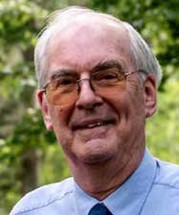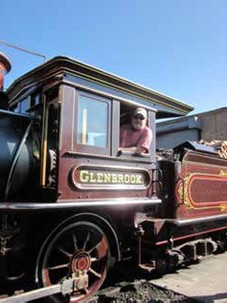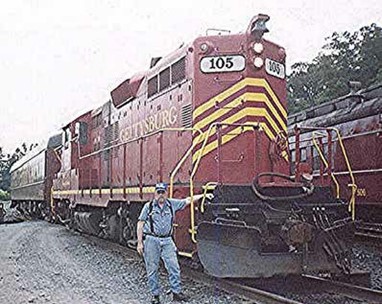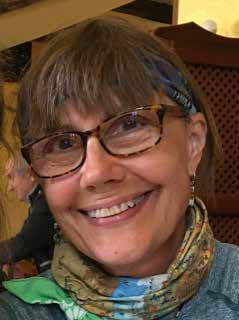May Clinic – May 20, 2024
Clinic – How Geology Determined the Denver-Gunnison Mainline of the DSP&P
Steve Hart Biography
Steve Hart is a retired geological engineer who has been fascinated by trains since traveling in an M-K-T passenger train pulled by a steam locomotive at age 9. After a 42-year career, including consulting on remediation at dozens of mines, mills, smelters, and radioactive waste Superfund sites, he began giving presentations on mining history to local, state, and national historical organizations.
In October 1872, Ex-Governor John Evans led the group of Denver businessmen incorporating the Denver, South Park & Pacific Railroad, with an objective of the San Juan mining region via the South Platte River. The shortest route between Denver and Silverton ran through South Park, Trout Creek Pass, and Gunnison, crossing three mountain ranges. Ten years later, the line was completed through the Alpine Tunnel to Gunnison, 200 miles from Denver, but still 125 miles short of Silverton. In that same period, the D&RG had reached Gunnison a year before the South Park and reached Silverton via La Veta and Cumbres Passes and the San Juan and Animas Rivers. Geology had played the key role in the race between the two railroads to reach the San Juans.
June Clinic – June 17, 2024
Colorado’s Narrow Gauge Railroads – A Synopsis by Tom Brunner
Tom Brunner Biography

Tom was born, raised, and educated in Southern California. After graduation from the College of Engineering at UCLA, he was hired by the Federal Systems Division of IBM to work on government projects. This began a 35-year career in developing computer software, which evolved from writing code, analyzing software performance, designing programs, estimating work efforts for tasks, and writing requirements for new projects. Since IBM also means “I’ve been moved”, he spent from 2 months to 14 years in a variety of places: Pasadena, CA and Houston, TX on NASA projects, north of Philadelphia, PA on a Navy project, and Seattle, WA, Thousand Oaks, CA, and Boulder, CO on Air Force projects. Tom and his wife have two children and six grandchildren. He enjoys visiting historic sites – buildings for his wife and trains for him. He has been volunteering at the Colorado RR Museum for over 20 years.
Colorado has an interesting and expansive railroad heritage – and much of it started as a narrow gauge. Two original segments, as well as one recreation, today exist as tourist railroads. Also, several museums and smaller displays contain significant artifacts of this history. If you do research and know where to look, many other remnants can also be found. Tom’s presentation will begin with a little history of several of these narrow-gauge lines, but the major portion will be pictures he has taken over the last 50 years of what can be seen in museums, displays, and “off the side of a side road”.
Clinic On Hold – Waiting on Date
Clinic – Process to develop a layout and determine a locale
Keith Hayes Biography


Keith Hayes is a Colorado native who started playing with his Dad’s Lionel trains at a very early age. Many summers reading Model Railroader and studying the plans therein resulted in a career in Architecture. Bill Wardell introduced Keith to Sn3 and when it came time to build a layout, the subject was going to be a freelanced Colorado pike. Choosing Leadville, CO as the subject of the first town has led to modeling the C&S between Leadville and Breckenridge, CO in the 1930s. Keith lives in Denver with his wife and three cats and regularly posts progress of the layout on the C&Sn3 blog.
Keith Hayes has prepared a clinic on the process he went through to develop his layout and determine the Colorado locale for the endeavor. The Colorado & Southern in the 1930s will describe the conception, planning and construction of Keith Hayes’ Sn3 layout set in Colorado. Note that this is a Sn3 layout in 1/64 scale.
Clinic On Hold – Waiting on Date
History of the Denver Tramway Streetcar .04
Wally Weart will present the above-mentioned Clinic. This was the last streetcar to operate in revenue in Denver, and it had several narrow escapes during its life. One of its escapes was the conversion from standard gauge to a narrow-gauge electric streetcar. Wally will add some history of the Denver Tramway network along with some additional pictures he has accumulated. Wally is a long-time member of the Front Range Division and the NMRA.

Clinic On Hold – Waiting On Date
How Fred Harvey Opened Up the American Southwest
There are some people who had a major influence in opening up the American Southwest. Fred Harvey, an immigrant from England, was on of the major influencers, along with his son, Ford Harvey. After arriving in America, Fred Harvey started as a pot scrubber in New York City. From there he built a family empire with an emphasis on fine dining and fine service with train travel. Fred started his business with a handshake agreement with Charlie Morse, Superintendent of the small upstart AT&SF Railroad. Later, with Ford Harvey’s business acumen, the empire expanded with iconic hotels and introducing the wonders of the American Southwest to tourists worldwide.

Christine Petty Biography

Christine Petty retired as a family physician in 2014 and then became enamored with travel and history. After learning about OLLI (Osher Lifelong Learning Institute) classes in 2015 and attending several, she became a facilitator with OLLI in 2017. Her classes have included Pilgrimages, 80 Gardens Around the World, The Great, Great Lakes, The History of the Great Influenza Pandemic of 1918 and Covid, Scandinavian Mystery Writers, Who was Fred Harvey, and Films about Death, Dying, and Loss. Since walking the Frances route of the Camino de Santiago in 2016, she became hooked on long-distance walks and travel, and has walked various routes of the Camino de Santiago, various pilgrimages in Japan and Scotland, various long-distance walks in various countries. This summer she completed the St. Olavsleden in Sweden and Norway. Christine serves as a Coordinator for the Colorado Front Range Chapter of the American Pilgrims on the Camino, and has done so since 2017.
